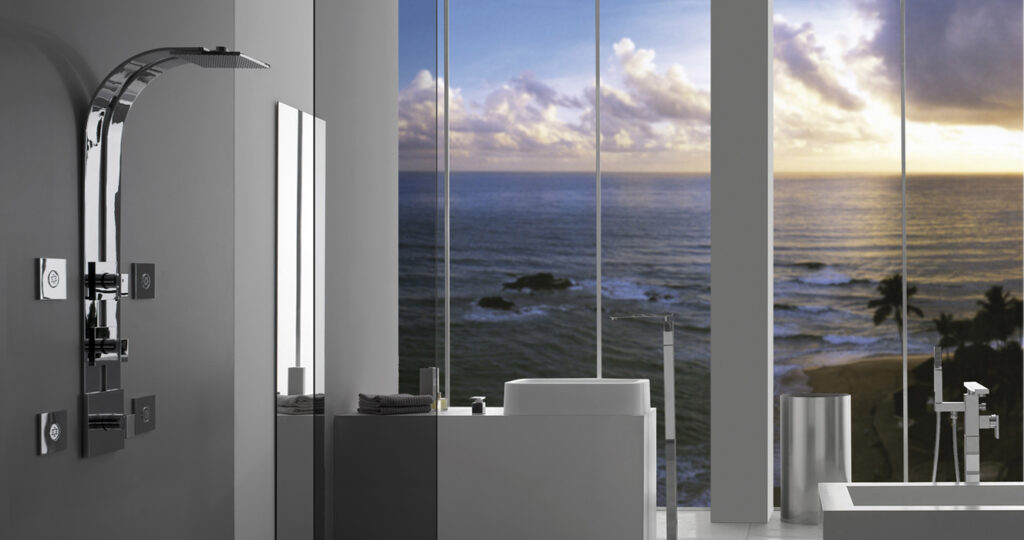Thermostatic Mixers – Pivot of Shower Systems
Thermostatic mixer has become an integral part of the shower system. Washroom and Beyond explores the technology behind thermostatic mixers and its applications in shower systems.
With changing consumer tastes and preferences, the washroom has gone through a lot of changes over the years. And, technology has been at the forefront of these changes. More so, technology has changed the way hot and cold water applications are being implemented in the washroom space. It is a well-known fact that hot bath water is responsible for the highest number of fatal and severe scald injuries in the home. Young and old are most at risk because their skin is thinner and less tolerant to high water temperatures.
Thermostatic mixers have come to the rescue and has become an integrate part of the modern day showers. Further innovations in thermostatic mixing has resulted in variations which provider higher safety measures while concealed behind a plate offering functionality while improving the aesthetics of the components.
Thermostatic mixers and operating mechanisms
Quite simply a thermostatic mixing valve is a device that mixes hot and cold water before discharging it at a stable temperature. Domestically thermostatic mixing valves are most commonly used as showers. However, it can be found in a number of other applications around the home ranging from controls on solar thermal hot water systems to taps and bidet controls. Outside of domestic installations TMVs are often used for safety reasons in hospitals and care homes, showering controls in sports centres and even process controls in factories. This is because warm water encourages bacteria to grow and hot water kills it but can cause scalds.
There are many types of thermostatic mixing valve in terms of how the product looks and also in terms of the capability of the product. However, there are also major differences in methods used to control the mixed water to enable the discharge of water at a stable temperature.
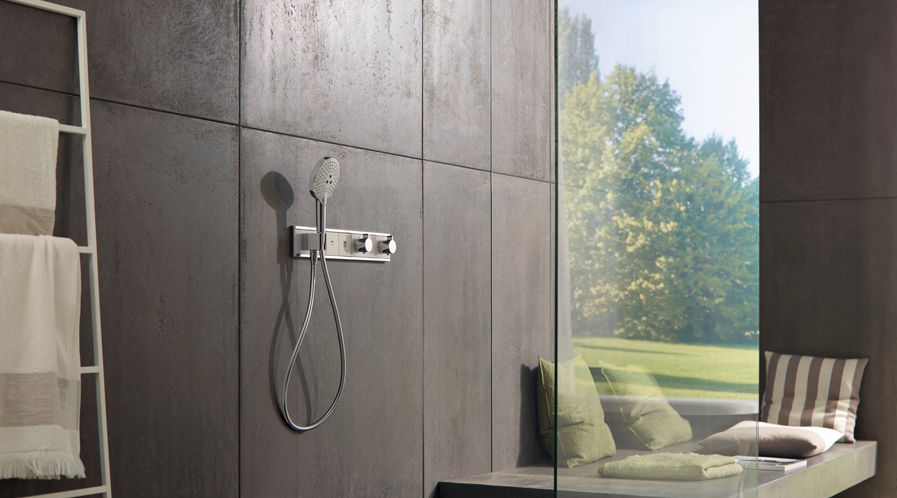
Wax capsule: A copper capsule containing a mixture of wax and fine metal particles is situated in the mixed water section of the valve. Heat transfer into the capsule causes the wax to expand, if cooled the wax contracts. As the wax expands it forces a metal piston out of the top of the capsule. This force is transferred on to a shuttle which moves forward and backward thus proportioning the amount of hot and cold water entering the valve.
Typically the movement of the shuttle, when the wax contracts, is made by a spring that acts on the shuttle as the wax capsule is only able to directly move the shuttle in one direction i.e. as the capsule expands. The wax capsule, in combination with the spring, continually move the shuttle to proportion that mix of hot and cold water thus maintaining a stable temperature. The wax capsule will attempt to maintain this stable temperature by compensating for inlet water temperature and pressure changes.
Bi-metallic: In this case a bi-metallic coil is situated within the mixed water chamber. When water flows over the coil thus changing its temperature, the coil expands or contracts accordingly. The movement of the coil is therefore used to alter the position of a shuttle which is attached to the coil. As with the wax capsule mechanism, movement of the coil changes the proportions of the hot and cold water entering the mixing chamber and thus maintains a stable temperature.
Electronic/digital: Electronic/digital methods of maintaining thermostatic control of water systems is somewhat in its infancy. However, these types of systems are starting to have an impact in the market. The hot and cold water supplies can be controlled by a number of methods from proportioning valves, pumps or motorised controls. Whichever system is used the water should be maintained at a stable temperature during normal use and operating conditions at the terminal fitting whether this is a pillar tap or a shower head.
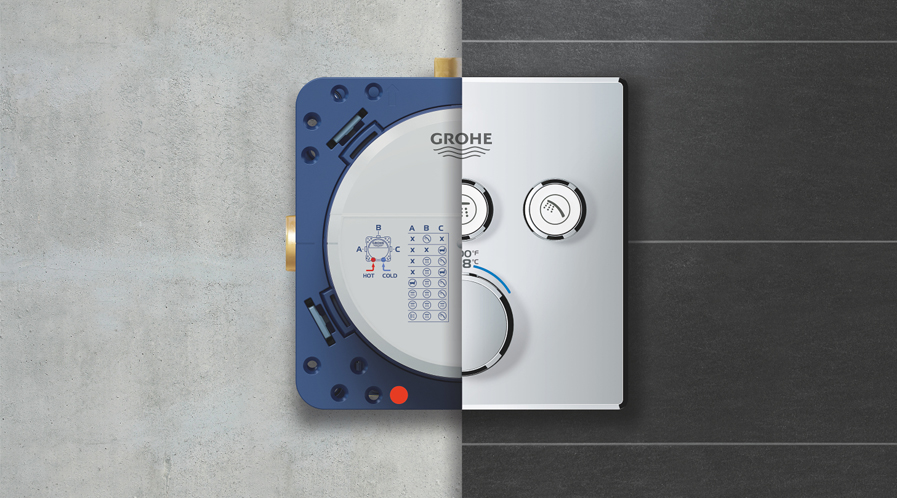
Differing Mechanical Configurations
As well as all the differing thermostatic mechanisms, TMVs can also come in a large variety of mechanical configurations.
‘T’ pattern: As the name suggests the configuration of these types of valves are typically in the shape of the letter ‘T’. The two horizontal connections opposite each other are for the hot and cold inlet supplies and the vertical connection is for the outlet mixed/blended supply water.
‘T’ pattern TMVs can also come with an array of accessories to enable a simplified routine maintenance schedule and to make the removal of a valve, should it be necessary, easier than with direct compression connections.
These valves are typically situated under a basin or bath and the mixed water outlet plumbed into a pillar tap or single lever mixer tap. They are usually set and locked to stop the end user from adjusting the maximum mixed water temperature as a safety precaution. They have no on/off flow control and therefore need to be paired with a pillar tap, mechanical single lever mixer or other suitable terminal fitting.
Showers – Single Sequential: TMVs are most commonly used as showers. However, there are a number of different configurations that need to be highlighted. Single sequential TMVs have one control that turns the water flow on and off and adjusts the temperature at the same time. Higher or lower flows typically cannot be selected without changing the mixed water temperature.
Showers – Dual control: Many TMV shower products have one control to turn the water flow on and off and a separate control to change the mixed water temperature. These controls are typically arranged as separate control knobs or as concentric controls.
Showers – Built in: As the name suggests these TMV showers have the body of the valve located either behind a panel e.g. a stud partition or are literally built into a solid wall. This effectively only leaves the control knobs exposed.
Showers – Exposed: These shower TMVs are literally mounted on the surface of the wall and usually allow for either surface mounted or concealed pipework. Most manufacturers offer different style options of the same shower TMV in both built-in and exposed versions – the major difference being the style the product offers to satisfy the needs of the end user.
Bath Shower Mixers: Bath shower mixing valves (BSM) are obviously designed to deliver water to either the bath or to a shower. As with showers and taps, there are a number of different designs available that offer differing options. Selection of outlet is usually by use of a diverter – these can be levers or manual diverters or automatic diverters (which return to the original outlet when the water flow is turned off).
Many traditional BSMs only delivered water to the shower that was mixed and controlled by the TMV part of the product. When delivering water to the bath outlet, these products act as a manual mixing valve. As a manual mixing valve the mixed water outlet is not controllable to a stable temperature in the same way as a TMV.
However, many manufacturers now offer BSMs that are truly thermostatic and thus thermostatically control the outlet water to both shower and bath outlets (when selected) to a stable temperature.
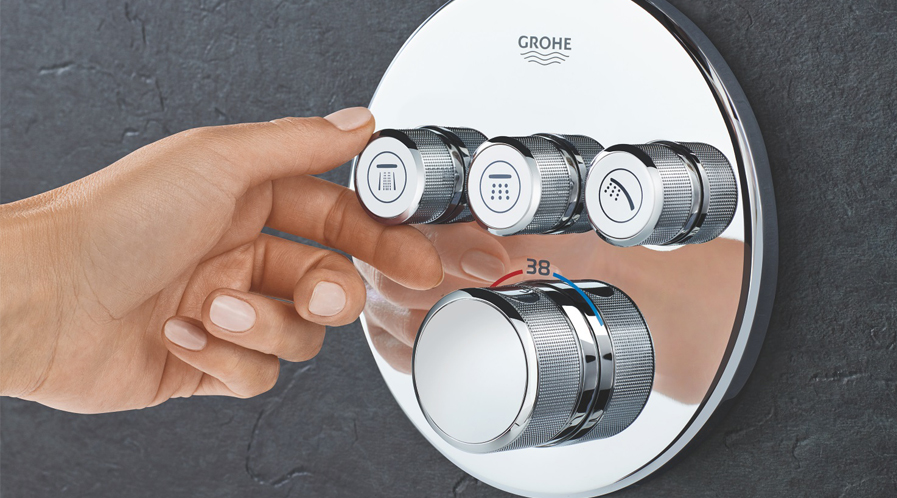
Factors affecting choice of product
Many factors may affect the final choice of TMV. The vast array of TMVs available to the end user, what benefits they offer and how well they can perform can seem bewildering. That is not to mention that cost and aesthetics will also be taken into account by the end user.
End use – safety capability: Typically the safety aspects that TMVs can provide are not the primary reason for selection within the bathroom environment. However, care should be taken to understand the safety features and the types of product approvals available and therefore what they may mean to the end user.
The TMV has to significantly reduce the flow of water through the valve in the event that the cold supply to the valve is lost. When the cold supply is stopped then the valve should not allow an excessive volume of water to be discharged. As scalding is a function of both temperature and volume, if this volume is exceeded then the temperature of the collected water cannot exceed 42°C. Obviously the hotter the water temperature then the smaller the volume required to cause scalds.
Water supply: Having considered all of the cost, aesthetic, control options and mounting options, it should not be forgotten that the TMV chosen also needs to be suitable for use not only for the desired application (bath, bidet, shower or washbasin) but also with the water supply system installed in the home.
Water supply systems typically are either high pressure or low pressure systems. Although in practice some high pressure supplies (typically cold supplies) are mixed with low pressure supplies (typically gravity fed hot supplies) these systems are not considered best practice and in particular, for supplies to TMVs nominally equal supply pressures are best.
Critical factors: TMVs, when selected, should be matched to the intended supply system. This is key to ensuring the safety functioning works correctly, minimising water waste and to gain optimum performance from the product.
If a valve designed only to be used on high pressure systems is fitted to a low pressure system then there may not be enough ‘energy’ in the water pressure to drive the mechanism. This can result in no or low flow rates but more importantly there is a danger that the TMV will not be able to provide safety in the event of a water supply failure thus not being able to prevent a scalding incident.
If a valve designed only for low pressure installations is fitted to a high pressure system then the mechanism within the valve may not be robust enough to deal with the pressures from the high pressure system to adequately control water temperature. This may result in the valve being unable to provide safety in the event of a water supply failure thus not being able to prevent a scalding incident.
In addition to this, excessive flow rates may be encountered during normal use as the flow pathways inside a TMV designed for low pressure systems are larger than those designed for high pressure systems thus resulting in wasted water.
Many manufacturers now produce TMVs that are suitable for both high and low pressure water supply systems. Typically this may need the fitting of flow restrictors or flow regulators to control the flow through the valve at high pressure. Flow regulators can be placed in the inlets to the valve (one for the hot supply and one for the cold supply), or on the outlet of the TMV (only one required in this case). Alternatively, they are sometimes placed in the hose or shower head of shower TMVs.
As manufacturers produce TMVs, in particular showers, for use on both high and low pressure systems care must be taken to ensure the correct fitting of the spray plate on the shower head. Shower heads are often supplied with a ‘low capacity’ and ‘high capacity’ spray plate to ensure that the delivery of water to the user is optimised. These spray plates have a varying number and size of holes to maximise the performance of the spray. If the high capacity plate is fitted to a shower installed on a low pressure system then the volume of water delivered may be increased but the performance of the spray to the end user will be poor.
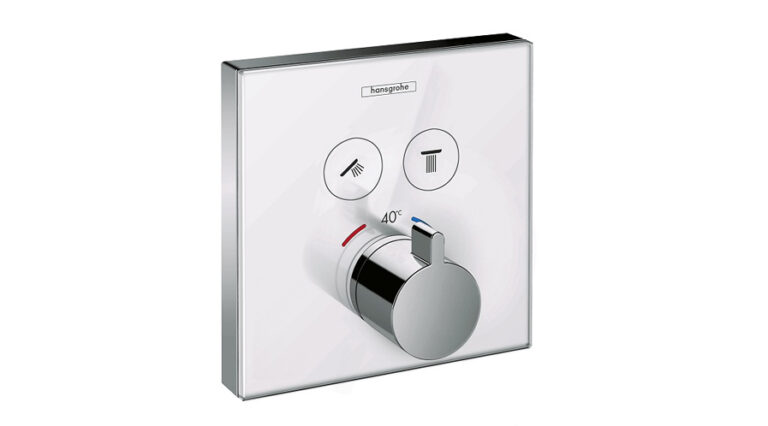
Product Applications
Thermostat has become an integral part of modern day shower systems. For example, Grohe Smart Control Shower combines multiple breakthrough technologies in one shower system. “It matches the intuitive interface of push button and volume control technology with the precise control of GROHE’s best-in-class thermostat along with industry leading shower head,” claims the company.
A Grohe release claims that thermostats in the Smart Control Shower adjust precisely to desired water temperature within 0.3 seconds. “Beyond that, GROHE thermostats constantly adjust the flow of hot and cold water so that the user never goes through a ‘hot’ or ‘cold’ shock in the middle of a shower. It also has safety features built in including automatic water cut-off in case either of water sources unexpectedly stop, the GROHE cool touch that prevents metal parts from heating up as well as a temperature lock system to prevent accidental changes in temperature setting.”
Hansgrohe has recently launched the new range of thermostatic mixers – hansgrohe RainSelect. “Generous, 70 x 70 millimetre switches make selecting shower settings a tactile experience. Operating them is similar to operating a light switch. Underlying this is hansgrohe’s Select technology, which controls the various functions on a purely mechanical basis. In addition to the switches for the various shower functions, two elegant dials control water volume and water temperature. A porter unit for the handheld showerhead and a hose connection are also part of the control centre,” informs the company.
The company further claims, “This makes RainSelect a clever product solution, rendering additional products and drilling unnecessary. There are two models to choose from for the shower area, and a separate solution for bathtub showers. An insulated, watertight and soundproofed base set is available for use with all RainSelect sets. Moreover, quality materials and reliable mechanics ensure long lasting functionality.”
Tags: Grohe Smart Control Shower, hansgrohe RainSelect, Shower Systems, Sustainability, Sustainable Washroom, Thermostatic Control, Thermostatic Mixers, Washroom Space, Water Supply Systems



